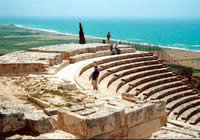|
|
| |
| |
| |
|
| |
 |
| |
|
| uses Google technology and indexes
only and selectively internet - libraries
having books with free public access |
|
 |
|
|
 |
|
| |
|
| |
Previous | |
Next |
|
 |
GIOVANNI MARITI
Travels in the Island of Cyprus
page 55 View PDF version of this page many grottos the entrances to which are made or squared with the chisel, and within are three or four niches fitted for corpses : the peasants call them the tombs of the Gentiles. Two hundred paces further are the quarries out of which were dug the stones used in building—not, I think, the ancient city, but rather— the fortress which I am about to describe.
The castle of Cerines is built on the seashore upon a rock : its foundation is clearly coeval with that of the ancient city, but it was enlarged by the Lusignan Kings. Europeans are not allowed to enter it, and the Turks look angrily at anyone who comes too near its walls. I was allowed to study them, and even to enter the. ditch which surrounds them. It is one of the best preserved forts which I have seen in this part of the world in the hands of the Turks, although some few years ago it was injured in several places by cannon-shots, aimed at it by Kior Mohammad Pasha to dislodge a party of insurgents who had fortified themselves within.
To give an idea of its construction I will borrow the words of a manuscript of the sixteenth century. " The shape of this little fort is an irregular oval. There are three old fashioned towers, hollow, weak and small, in the fourth corner is a bastion, badly planned and weak. The ditch is 21 paces broad and 370 round: the walls are four paces thick on foundations of six paces, and their height over 16."
Its situation is highly unfavourable, for the hills are barely a mile and a half away. Nevertheless King Jacques, natural son of King Jean, after a siege of two years, and various assaults by the Saracens could not take it. It surrendered at last in 1462 through the treachery of Sor de Naves, who commanded its garrison in the interest of Carlotta, the legiti-mate heir to the crown of Cyprus.
The Queen, as we learn from Scipio Ammirato (Book XXIII. November 10, 1461), "came to Florence when Ales-sandro Macchiavelli was Gonfaloniere, on her way to Rome to beg the Pope's aid against Jacques, her bastard brother, who
4—2
CH. vin] The Town and Fortress of Cerines 5.1
View PDF version of this page
|
 |
| |
Previous |
First |
Next |
|
|
|